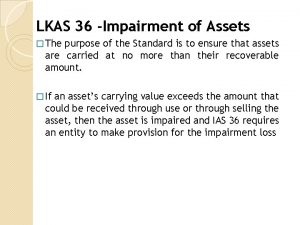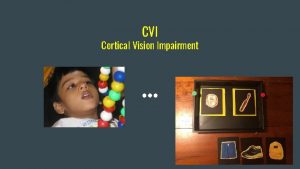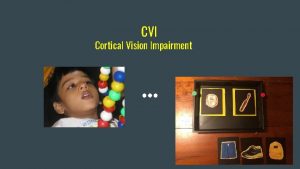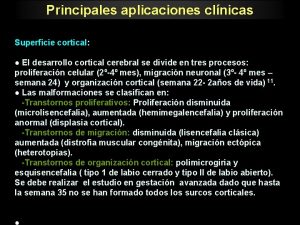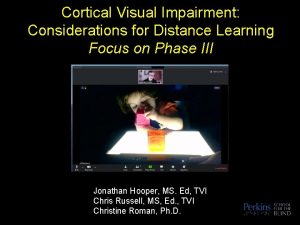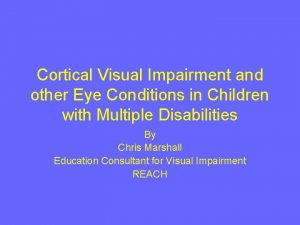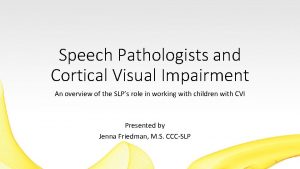CVI Cortical Vision Impairment What is CVI Cortical


























- Slides: 26

CVI Cortical Vision Impairment

What is CVI? Cortical visual impairment (CVI) is a decreased visual response due to a neurological problem affecting the visual part of the brain. The following criteria must be met to be diagnosed: • Normal eye exam or eye condition that cannot account for the abnormal visual behavior. • History or presence of neurological problems, brain damage, or condition that profoundly affects the brain • Presence of specific CVI characteristic behaviors. It is one of the most frequent causes of visual impairment in children from developed countries.


What causes CVI? CVI is caused by any process that damages the visual parts of the brain. Examples include: ● Brain damage from prematurity ● Stroke ● Decreased blood supply and/or decreased oxygenation ● Brain malformation or infection ● Hydrocephalus (increased pressure in the brain) ● Seizure ● Metabolic disease ● Infection ● Head trauma ● Neurologic disorders

Does Vision Improve with CVI? As the brain matures new connections can develop in the brain to overcome the initial injury or deficit and improve the function, however it is difficult initially to predict future visual function. Interventions based on the characteristics seen in children with CVI can help maximize performance. YES! It can. Interventions, adaptations, and the correct learning environments allow kids with CVI to learn and improve their functioning. HOWEVER It does not fully resolve, they will continue to be impacted by difficulties.

CVI typical Characteristics: ● ● ● Color Preference Movement- either needed or unable to see when in movement Visual Latency (delay) Visual Field Preference or loss of peripheral fields, often lower Difficulty with Visual Complexity: array of objects, faces, sensory environment, surface Cited: Dr. Roman-Lantzy

Characteristics cont. ● ● ● Need for or attraction to light Difficulty with Distance Viewing Atypical Visual Reflexes Difficulty with visual novelty, lack of visual curiosity Difficulty with visually Guided Reach


Why does their vision seem to change? CVI is a complex visual impairment. Many factors go into why a person with CVI seems to see one day or one hour and then not the next. Just a Few Factors: ● ● ● ● Lighting Familiar vs unfamiliar space Noise Routine with familiarity vs. novelty Fatigue, motivation, and general health Complexity and contrast Visual fields and distances

How Do I Teach a Child with CVI? 1. 2. 3. 4. 5. 6. 7. 8. Understand what CVI means Read the student’s medical history Consult with a TVI (teacher of the Visually Impaired) Find out where the child is on the CVI Range Use the information gathered to discuss strengths and needs Use a Universal Design Approach (UDL) since it is good for all learners Make adaptations to materials with the help of the child’s TVI Keep assessing and re-evaluating what is working and needs improvement


Ideas and Tips for CVI Kids ● ● ● ● ● Use of a black background Bold colors (yellow and red are prefered colors) Make a calm and uncluttered work environment that nurtures learning Use predictable outcomes in class with lots of routine Give extra time, repetition, and show patience Give few choices and slow to introduce novelty Simple directions Allow for breaks, especially visual breaks It’s ok if they are not looking at you, as long as they are listening Use dark font that is larger and less cluttered










The Blind Woman who saw the rain, Skunk Bear

Through My Eyes by Alfie Fox


Resources Little Bear Sees http: //littlebearsees. org/ APH CVI site https: //cvi. aphtech. org/ CVI Scotland https: //cviscotland. org/index. php Perkins CVI learning https: //www. perkinselearning. org/cvi

References https: //cviteacher. wordpress. com/three-phases-of-cvi/ http: //littlebearsees. org/ https: //aapos. org/glossary/cortical-visual-impairment Roman-Lantzy, Christine. Cortical Visual Impairment: an Approach to Assessment and Intervention. AFB Press, American Foundation for the Blind, 2018. Lueck, Amanda Hall, and Gordon Dutton. Vision and the Brain Understanding Cerebral Visual Impairment in Children. AFB Press, 2015.
 Nursing management of patient with cataract
Nursing management of patient with cataract Nursing diagnosis for vision impairment
Nursing diagnosis for vision impairment Nursing diagnosis for vision impairment
Nursing diagnosis for vision impairment Nursing diagnosis for meniere's disease
Nursing diagnosis for meniere's disease Myringotomy incision
Myringotomy incision Cvi phase 2 activities
Cvi phase 2 activities Visual search
Visual search Cvi characteristics
Cvi characteristics Teach cvi
Teach cvi životopis u obliku sastavka primjer
životopis u obliku sastavka primjer Human vision vs computer vision
Human vision vs computer vision Impairment related work expenses
Impairment related work expenses Intermediate accounting kieso
Intermediate accounting kieso Patofisiologi mata
Patofisiologi mata What is the difference between depreciation and impairment
What is the difference between depreciation and impairment Impairment rating chart
Impairment rating chart Impairment vs disability vs handicap
Impairment vs disability vs handicap Environmental impairment insurance definition
Environmental impairment insurance definition Impairment of accounts receivable
Impairment of accounts receivable Limbic system impairment quiz
Limbic system impairment quiz Impairment loss of receivable
Impairment loss of receivable Other health impairment definition
Other health impairment definition Hearing impairment meaning
Hearing impairment meaning Ias 36 impairment of assets ppt
Ias 36 impairment of assets ppt Ditep
Ditep Patent impairment
Patent impairment Qmci
Qmci























